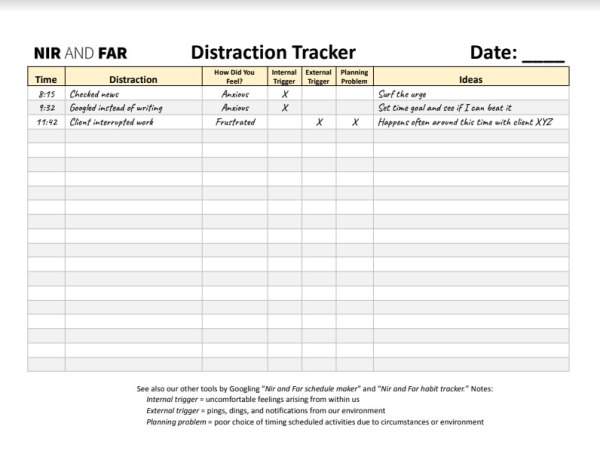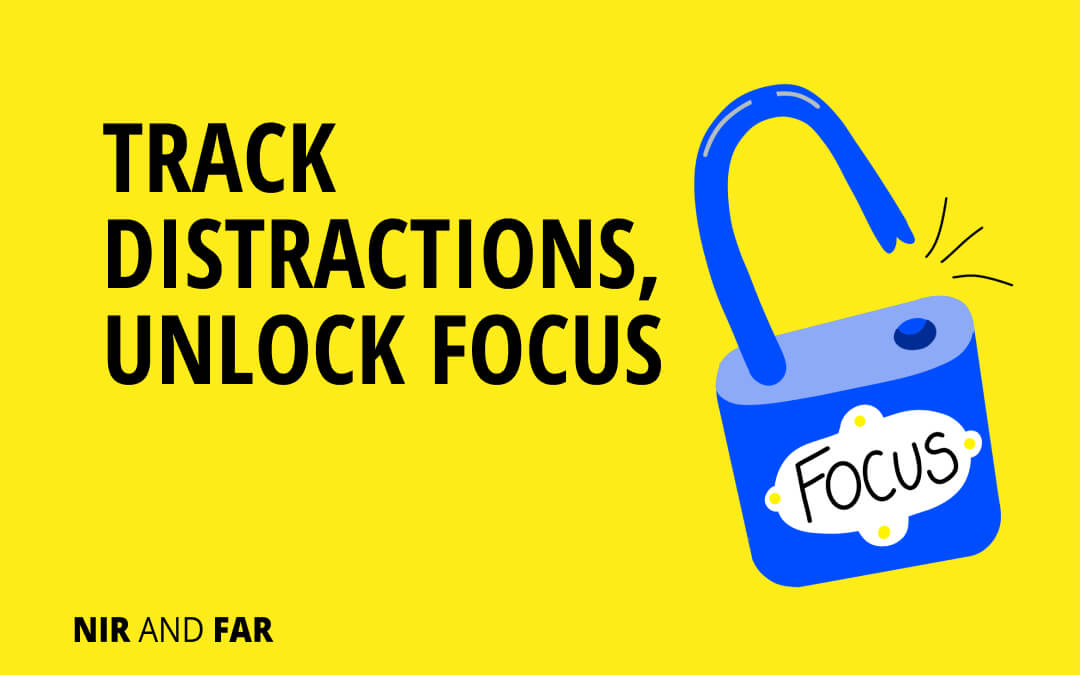- There are only three causes of any distraction: an internal trigger, an external trigger, or a planning problem. A distraction tracker is the only way to help you figure out which of those is causing you to get distracted so you can do something about it.

Distraction tracker: click to download this free Google sheet template
…Deal with Internal Triggers
- Look for the discomfort that precedes the distraction, focusing on the internal trigger.
- Write down the trigger.
- Explore your negative sensations with curiosity instead of contempt.
A distraction tracker plays a key role in this process.
The idea is to write down the trigger—whether you give in to it or not—as soon as you notice it.
You may experience some frustration during this process. Internal triggers are trickier to identify than external triggers. It’s a lot more difficult to pinpoint our own feelings than to notice the ping of a text message or a knock on your door.
Jonathan Bricker, a psychologist at the Fred Hutchinson Cancer Research Center in Seattle, has advice for you. He has studied how changing patient behavior—reducing how often a person smokes, for example—can reduce risk of cancer.
Bricker recommends discussing the internal trigger as if you were an observer, telling yourself something like, “I’m feeling that tension in my chest right now. And there I go, trying to reach for my iPhone.”
The better we are at noticing the behavior and the feeling behind it, the better we’ll be at managing it over time.
Free Distraction Tracker
Reclaim control of your attention today.
Your email address is safe. I don't do the spam thing. Unsubscribe anytime. Privacy Policy.

…Filter Out Obnoxious External Triggers
Today, much of our struggle with distraction is a struggle with external triggers.
There are so many of them: the pings and dings of email, online chats, and social media notifications on our phones; work interruptions like meetings, or colleagues popping their head in; or even a messy desktop.
One compelling result of using a distraction tracker to record external triggers is that it shows you just how much of your time is stolen from you throughout the day.
Once you see how often you’re interrupted, by person or technology, you’ll finally be able to see why you struggle to complete daily tasks.
Then you’ll have the knowledge you need to hack back at the external triggers that pop up most often on your distraction tracker.
…Work Around a Planning Problem
Despite our best intentions to pack as much into a day as possible, we have to plan a schedule that actually suits us and isn’t purely aspirational.
That’s one reason timeboxing is the best time management technique out there: It’s iterative. I recommend booking 15 minutes on your schedule every week to reflect and refine your calendar to meet your needs.
And, surprise, a distraction tracker aids you in figuring out where you struggled to adhere to your timeboxed calendar. You can use it to help you to answer the question “When in my schedule did I do what I said I would do, and when did I get distracted?”
If the distraction tracker reveals that a planning problem was the reason you gave in to distraction, then ask yourself, “Are there changes I can make to my calendar that will give me the time I need to better live out my values?”
By looking at the times on the distraction tracker, you might be able to detect a pattern. Perhaps you’re more often distracted in the morning, or you always seem to struggle with distraction in the 30 minutes after a meeting.
Once you notice those planning issues, you can work around them: Maybe you prefer to tackle easier tasks in the morning and schedule focused work for the afternoon; maybe after a meeting you need time to answer emails or take a break before diving into the next big task.
Related Articles
- Schedule Maker: a Google Sheet to Plan Your Week
- Habit Tracker Template in Google Sheets
- The Ultimate Core Values List: Your Guide to Personal Growth
- Timeboxing: Why It Works and How to Get Started in 2025
- An Illustrated Guide to the 4 Types of Liars
- Hyperbolic Discounting: Why You Make Terrible Life Choices
- Happiness Hack: This One Ritual Made Me Much Happier

